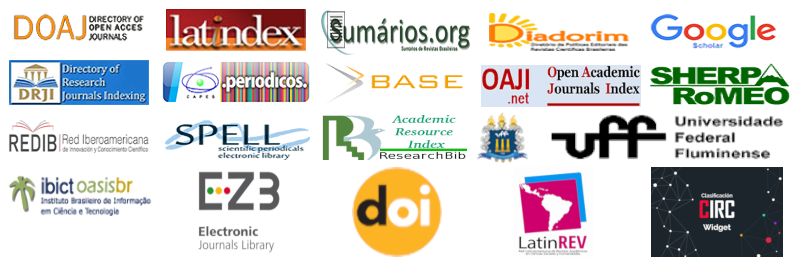Submissions
Submission Preparation Checklist
As part of the submission process, authors are required to check off their submission's compliance with all of the following items, and submissions may be returned to authors that do not adhere to these guidelines.- The contribution is original and unpublished and is not being evaluated for publication by another journal. Obs .: The paper can come from Thesis, Dissertation, Monographic works, or congress article, as long as they have been significantly modified. In this sense, the measure is no more than a 3% similarity in the CopySpider anti-plagiarism software.
- The manuscript is formatted according to the template file of RASI. The submission file must be in Microsoft Word format (doc, docx or rtf). Submissions in other formats will be rejected in the desk review phase.
- The text follows the style standards and bibliographic requirements described in Guidelines for Authors on the page About Journal.
- The submission should not be identified under any circumstances. If sources of tables or references allow identifying the authors, they must be removed and informed to the editor in a complementary field of the submission.
- The text is between 6,000 and 9,000 words and follows a structure with an introduction, concepts (literature review), methods, presentation of results, discussion, and conclusion, beyond bibliographical references and attachments (if necessary).
- The abstract must use a maximum of 250 words and follow the structure of item 3.1 of standard NBR6028:2003 for informative summaries (objective, method, results, and conclusions of the document). Abstracts that follows the standard of the Emerald publisher (purpose, design/methodology/approach, results, practical implications, practical and original implications/value) or IMRad method (Introduction, Methods, Results, and Discussion) are also accepted.
- The author(s) are aware that in being approved there is an article processing fee in the amount of R$ 300.00 (three hundred reais) for the publication (value updated after July, 1st 2021) to manuscripts submitted after this date.
- We suggest that the draft has at least two references from papers already published in the RASI (or justification, if there are no articles in the submission area that can be referenced) and that at least 90% of the references are of indexed scientific articles.
- The draft is formatted according the template of RASI.
- Check if the use of language models (Large Language Models – LLMs, such as ChatGPT) or generative artificial intelligence, as per the journal's policy, has been informed, when applicable.
Scientific papers
This category covers papers that report on any type of research undertaken by the author(s). The research may involve the construction or testing of a model or framework, action research, testing of data, market research or surveys, empirical, scientific, or clinical research.
Technical papers
Work focused on the use of theoretical models as a way to present and unveil knowledge, knowledge, and praxis about organizations. It is important that this paper presents one of the following points:
Focus on innovation: the authors' develops new solutions to new problems;
Focus on improvement: the authors' develops new solutions to known problems;
Focus on extrapolation: the authors' extends known solutions to new problems.
Literature review
Paper with the main objective of identifying, organizing, analyzing, and/or criticizing the literature on a specific topic. It should cover the main contributors to the development of a theme and explore its different views.
Papers with bibliometric analysis techniques are accepted as long as they bring some additional contributions to the studied field. Preferably the construction of an analytical framework, model, or method that can be explored by other authors.
Teaching Cases
Although there is no strict and unique structure for Teaching Cases, we recommend that the papers submitted in this section be structured under two broad axes (or parts): the case in question; and teaching notes (essential for their application in the teaching-learning environment).
The structure proposed for the Teaching Case:
- Introduction that exposes the problem situation to be debated;
- Presentation of the case (history itself), with the description and/or profile of the organization and conduction to the problem situation;
- References
Proposed Structure for Teaching Notes:
- Teaching Objective
- Sources and Methods of collection
- Relations with the objectives of a course or discipline
- Disciplines suggested for the use of the case
- Possible tasks and/or issues for implementation
- Possible organization of the class to use the case
- Suggestions for bibliography
Theoretical Essays
Paper focused on the discussion and development of theories. It should not be confused with "bibliographic review". The theoretical essay must, necessarily, advance in relation to the literature employed, bringing clear contributions to the field of knowledge.
Copyright Notice
RASI, in accordance with Law No. 9,610 of February 19, 1998, which amends, updates and consolidates Brazilian copyright law and makes other provisions, adopts the following conditions of the Copyright Assignment:
1. RASI maintains, with the transfer of copyrights, the possession of rights over the content published;
2. The author retains his moral rights of the content, including the right to be identified as the author whenever the content is published;
3. Despite the attribution of copyright, the author retains the right to reuse the material in future collections of his own work without encumbrance. The acknowledgments of the previous publication in the RASI are the only requirements in such cases;
4. The author may make photocopies of the content, or distribute it by electronic mail or fax, provided that they are intended for their own classes and for the purpose of meeting research objectives, provided that: (a) such copies are not resold and (b) reference to the original source of the publication and the name of the RASI are clearly indicated on all copies made of the document.
Privacy Statement
The names and email addresses entered in this journal website will be used exclusively for the stated purposes of this journal and will not be made available for any other purpose or to any other party.










